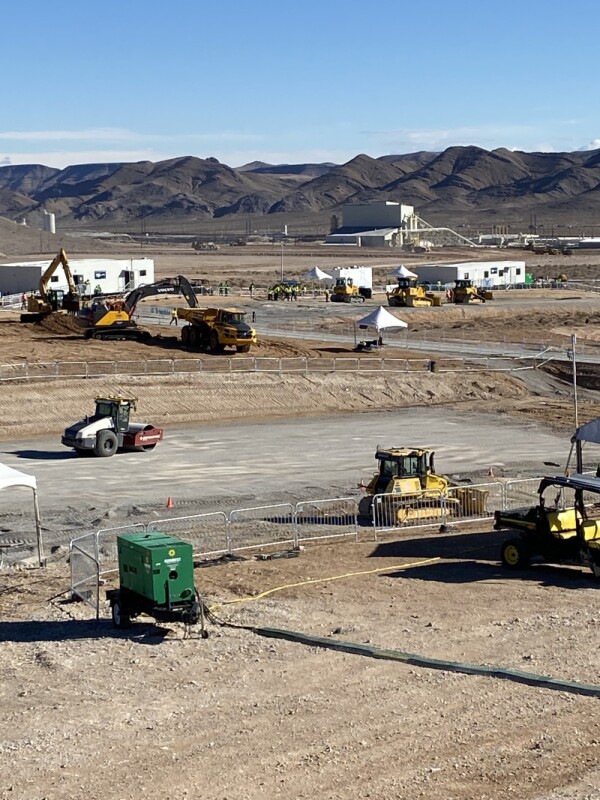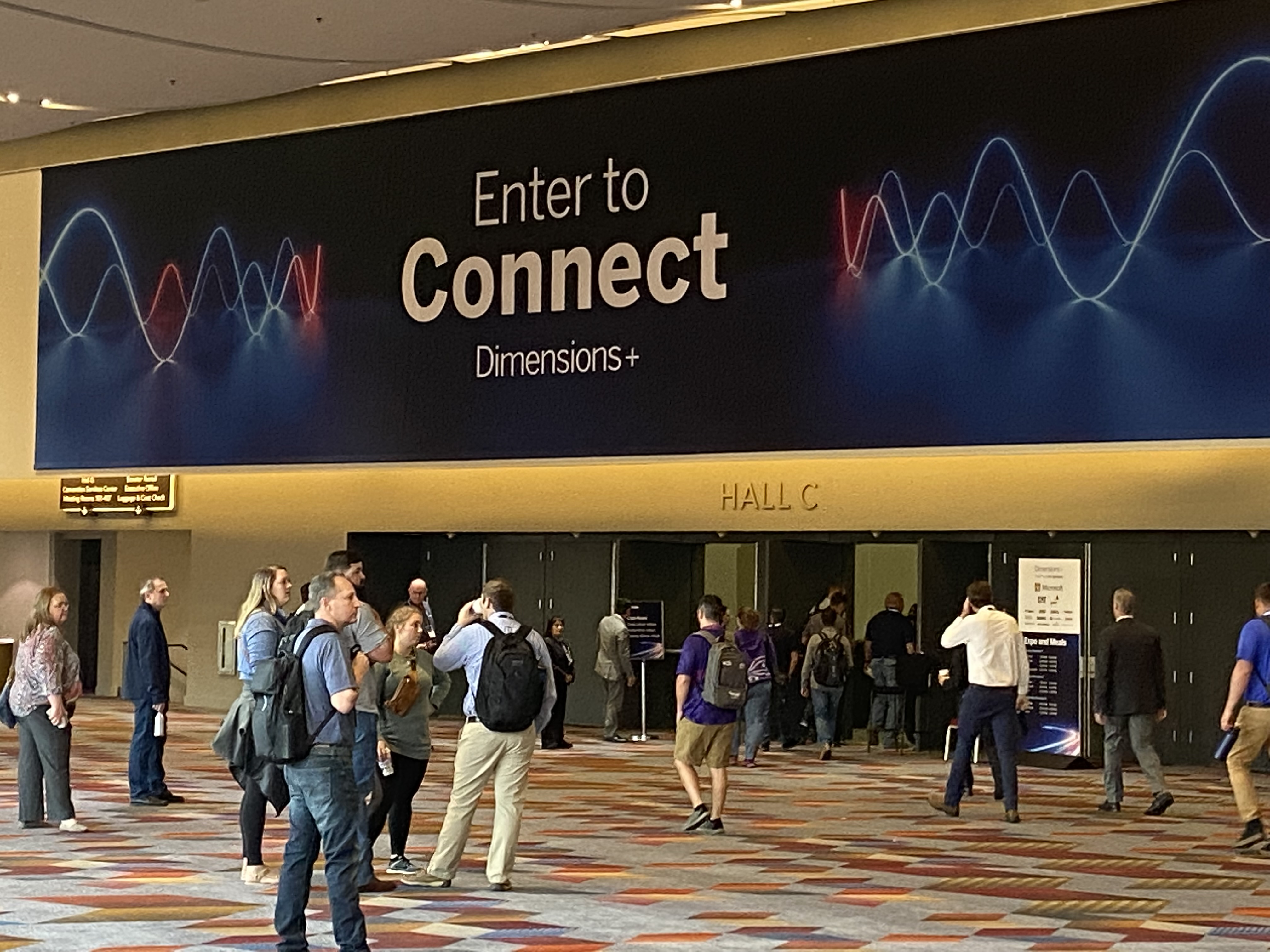After a four-year hiatus due to the COVID-19 pandemic, Trimble was able to hold their annual Trimble Dimensions+ conference earlier this month in Las Vegas, Nevada. It was a packed event with nearly 6,000 attendees on hand representing 62 nations around the world, the largest Dimensions event the company has thrown. With an exhibit hall featuring some of Trimble’s partners and other organizations in the construction technology space, an impressive off-site expo allowing for first-hand looks at some of the hardware innovations from the Trimble team, and a vast array of speaker sessions covering everything from reality capture to autonomy to software workflows and plenty more, there was plenty to take in and take home from this event. Below are just a few of the biggest takeaways from this three-day event.
All-In on Autonomy
This event was so vast and covered so many areas that it’s impossible to have just one main takeaway from all of the speaking sessions, but if forced to choose just one autonomy would have to be the choice. This was a broad throughline that could be felt in most every session Geo Week News attended, and walking throughout both the exhibitor floor as well as the off-site expo it was a theme that was on full display as well. Autonomy takes on a lot of different meanings, too, with the event touching on autonomous workflows regarding all areas of a worksite, including reality capture capabilities with drones and robotics, autonomous equipment that can complete projects without workers inside the machine, and software to automatically complete key functions away from the site.
Often, it was the autonomous hardware that stole the show throughout this event, if for no other reason than the ease with which it can be displayed. The exhibitor floor was temporary home to a few Spot robots from Boston Dynamics, showing off its capabilities for autonomously capturing work sites when integrated with scanners like Trimble’s X7 laser scanner. In fact, one of Trimble’s big announcements from the event was a collaboration with autonomy leader Exyn on a proof of concept for a fully autonomous robotic solution. All of this was discussed in one particular session led by Brian Ringley, Construction Product Manager at Boston Dynamics, and David Burczyk, Construction Robotics Lead at Trimble.
While the Spot robot was often the headliner for many of the autonomous solutions in the event hall, out at the off-site expo it was autonomous equipment. Whether it was an excavator on a man-made lake showing off automated dredging capabilities with the assistance of a remote controlled surveying boat, or autonomous pavers which can work alone in a predetermined area, to drones that could be sent out to complete surveys with Trimble payloads, there was a bevy of autonomous tools on display. Similarly, with all of the geospatial surveying and reality capture technology on display collecting immense amounts of data, just as important were the autonomous software workflows allowing for key insights to easily be made from this data without arduous and highly technical human intervention.
Not everything on display at the show are things that are currently available for commercial purchase, but it was certainly a look into the future of the construction industry. With hiring shortages putting even more of a premium on how workers are spending their time, the more tasks that can be completed by these autonomous machines will be hugely beneficial to AEC firms. This will also make job sites safer with machines being able to complete tasks that may have been hazardous to human workers, and will increase efficiency at a time when construction is expected to boom in the coming years.

Integrate Wherever Possible
It’s no secret that the construction industry is one with a reputation for being slow to adopt technology, some of which is fair and some of which not as much. The industry is certainly changing in this regard, with the pandemic in particular being a big reason for an explosion in technological adoption in recent years, but there is still work to be done. If you ask people in the space why they think that reputation is there and, to whatever extent, the hesitancy towards technology exists, one of the most common answers you’ll hear is the fragmentation of solutions. There are a lot of great solutions to solve specific problems, but often firms have to purchase and utilize all of them separately, which is an undertaking these already overworked organizations just can’t afford, financially and in terms of time.
With that in mind, it makes sense that integration of different products was a major focal point at the Dimensions+ show this year, starting right with the keynote address from the company’s CEO Rob Painter. Given the time elapsed between events mentioned above, Painter had a lot to get to in his event-opening speech, but this integration and seamless working between products was a big part of it. One of the big announcements was the integration between Trimble’s solutions and those from Microsoft, allowing for communication with Teams while working together on a solution. Painter also discussed more seamless integration between Trimble solutions, and another one of the company’s big announcements was an integration with their Viewpoint Vista solution and Hilti Group’s ON!Track asset and tool tracking software.
The construction industry needs to be more technologically sound moving forward to meet the coming demands of growing urbanization and infrastructure renovation amid climate change and general aging, and this kind of integration is going to be a key step there. Firms are willing to adopt these tools, so long as the time it takes to actually derive that value is worth it.
Making Remote Work Easier
The pandemic changed the way most every sector did business, with many of those changes poised to continue in the post-pandemic period, and the construction industry was no different. For most of history, the vast majority of work for a construction firm was done on-site. With the pandemic forcing many into remote work, this is an industry that had to adjust on the fly and significantly change the way they did business. Many of the products on display at Dimensions+ highlighted these changes, and the willingness of Trimble and other companies to adjust with the industry to make this work easier.
Some of this ties back to the machinery present at the off-site expo. Specifically, they showed off a bulldozer that was controlled remotely to complete tasks on site. While in this case the remote operator was on site a few hundred yards from the machine, theoretically this technology could allow for machine operators to be located in a different state, or even country. Further, many of the software tools Trimble discussed at this event had new features allowing for easier remote collaboration. Whether it be the integration with Teams to allow for that real-time collaboration while being off-site, or visualization tools to simplify designing and inspection away from a site, or design tools with annotation capabilities to ensure seamless collaboration between different stakeholders, it’s clear that Trimble is taking the shift to remote work seriously, and making sure customers can continue to work productively and efficiently even when away from a work site.






